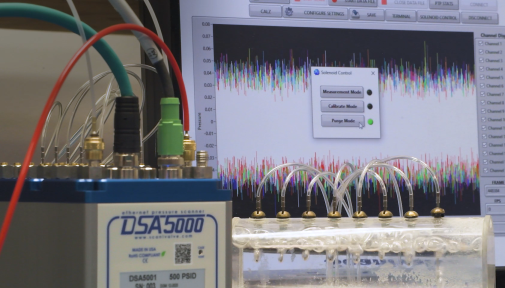Pressure scanner aids development and testing of aerodynamics and propulsion systems
A new digital pressure scanner, the DSA5000, has been introduced by US manufacturer Scanivalve after spending two years in the development process.
The results of the development activity at Scanivalve is a versatile, self-contained data acquisition system, which is both rugged and fully-customisable with a range of electrical and pneumatic interface options, making it ideal for use in a wide range of applications such as gas turbine testing, flight test, wind engineering and other industrial and defence industry applications. The user-friendly interface also offers straightforward operation in small projects in education, research and test house facilities where low channel counts are required.
Each channel uses a dedicated pressure sensor, with all data acquisition, data conversion and communications being handled on-board. Uniquely, the DSA5000 makes use of an individual 24-bit A/D converter and RTD for each sensor allowing fully, truly synchronous, data collection. Data can be delivered at rates of up to 5,000Hz per channel in a wide variety of engineering units.
Connectivity
A new and interesting form of connectivity was also developed specifically for the DSA5000 using an innovative ring-architecture capability in which multiple DSA5000s can be connected together through miniature Ethernet connectors. This delivers a fully integrated, multi-drop architecture, industrial network configuration for pressure scanning instrumentation.
Using this architecture creates an isolated, mini-network where the “master” unit serves as a single point of communications for all scanners in the mini-network. Scanners are automatically identified, easily configured and accurately synchronised. Data from all scanners are merged to provide a single output data file with pressure and temperature values from all of the connected Scanivalve 5000 series scanners.
Robust Design
The smart, fast and highly accurate DSA5000 hasn’t had its sensitivity compromised for use in extreme environments with the instrument having been cased in an IP67 rated aluminium container, which is rugged and lightweight, with an option to install a self-controlled internal heater which allows operation in ambient temperatures as low as -50°C. The DSA5000 can also be fitted with an optional shock-mount kit, which has been tested to MIL-STG 810G Cat. 24, 514.6.
Aerospace Application
Offering a multitude of pressure ranges from 4”H2O (0.18psi) to 1,000psi (at launch) in several pneumatic configurations means a DSA5000 can be configured for low pressure aerodynamic tests, high pressure compressor tests, and everything in-between.
Aircraft are extensively tested and designs are validated before production can begin. Testing begins with computer-based modelling, such as CFD (Computational Fluid Dynamics), followed by wind tunnel and laboratory testing. Finally, all aircraft must be tested under “real-world” flight conditions. Instrumentation used to gather and record the test data must not only be rugged and compact, but also able to withstand extreme temperature, shock and vibration.
Aerodynamic testing in aerospace has a unique set of challenges. When in flight testing, the scanner must be able to operate consistently at extreme temperatures.
Whether the DSA5000 is used in the wind tunnel or on aircraft for measurement and validation, it provides valuable data to help produce higher performance, safer and more efficient aircraft.
According to Paul Crowhurst, Managing Director at Evolution Measurement, the instrument will be of significant benefit to the aerospace and defence industry as the world embarks on more advanced airframe and gas turbine engine development.
“Never before have we seen this level of capability in a pressure instrument and it is going to revolutionise aerodynamic development,” he says.

